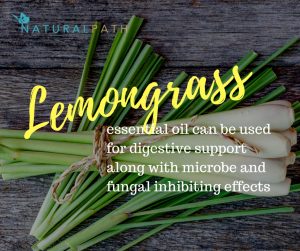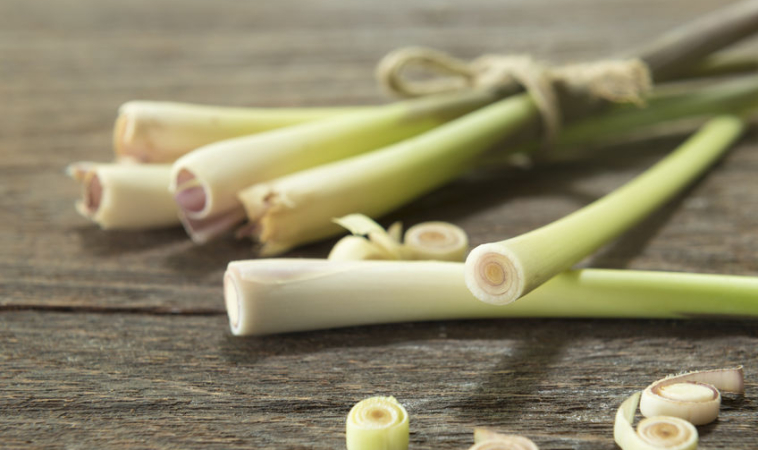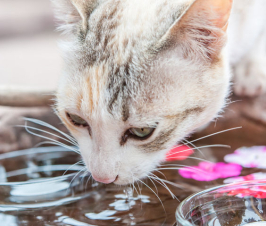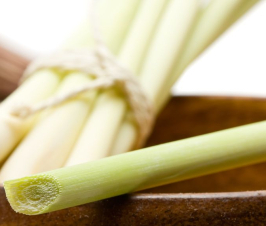Lemongrass: an essential addition to your essential oil collection
Sarah LoBisco, ND
 I was recently inspired to dive into research on lemongrass essential oil. The impetus was when I noticed it had not been worthily highlighted on my essential oils database. This essential oil holds a special place in my heart and by my diffusor for many reasons. These motives don’t follow the traditional and most popular applications for digestive support, its microbe and fungal inhibiting effects, or the role it plays in inflammation modulation,1-4 though they are intriguing. I’ll dive into the many noteworthy aspects of lemongrass oil in this blog series. First, let’s begin with how my love for lemongrass started with the adoption of my four-legged furry friend, Kiara Kitty.
I was recently inspired to dive into research on lemongrass essential oil. The impetus was when I noticed it had not been worthily highlighted on my essential oils database. This essential oil holds a special place in my heart and by my diffusor for many reasons. These motives don’t follow the traditional and most popular applications for digestive support, its microbe and fungal inhibiting effects, or the role it plays in inflammation modulation,1-4 though they are intriguing. I’ll dive into the many noteworthy aspects of lemongrass oil in this blog series. First, let’s begin with how my love for lemongrass started with the adoption of my four-legged furry friend, Kiara Kitty.
Lemongrass and (Kiara) Cats
In part (paw) I of this series, found on my homepage, I go into the story behind Kiara’s broken hind leg and how she gave lemongrass “ap-paws.” My mom and I originally selected lemongrass for our little buddy’s deformity since it had a good safety profile in people and more importantly, in cats. Felines have been said to have an increased sensitivity to certain volatile compounds, so finding an essential oil that is powerful and safe is a home-run hit! Although this is a theoretical risk, related to the fact that cats are missing an enzyme (glucuronyl transferase) that is found in humans and is important for the metabolism of many essential oil constituents, it’s still a consideration. What my mom and I didn’t expect was Kiara’s fast recovery and her recurring request for its diffusion of her new favorite scent. You can read more about that here.
Part I Recap
Part (Paw) I discussed how lemongrass essential oil’s protection against fungus and its ability to prevent “paw edema” were likely some of the reasons Kiara Kitty benefited from its aroma.4 Lemongrass essential oil also has some very impressive cell protecting properties, including DNA protection in rodents, which I further reported on in my previous article.
It is a common misconception of many two-legged and four-legged creatures that dispersing essential oils’ volatile components into the air are simply for relaxation. This truly underestimates the power of oily-odor-emitting companions and “scent-sational smell” in the air.
Although calming the brain and modulating stress is a powerful healing modality, essential oils not only calm the brain due to their aroma and its emotional associations, but also their biochemical effects, which I discuss here.
Now, I’ll dive deeper into the “aromatherapy” benefits of lemongrass essential oil.
The Olfactory Underappreciation of Diffusing Lemongrass Essential Oil
There have been several studies specific to lemongrass that demonstrate its power in vapor phase. One study found that as compared to the liquid phase, exposure to vapor of the oil resulted in superior inhibition of several tested fungal strains. The authors stated:
The use of the vapor phase has the additional advantages of ease of application and avoiding the need for direct contact with the oil. Furthermore, a smaller volume of LGEO is required to achieve the same level of inhibition. Our findings are in conformity with previous publications (25). An 80% decrease in airborne microorganisms was achieved when the vapors of an LGEO blend were dispersed continuously for 20 h by a fragrance generator, suggesting its potential for use as air decontaminant in hospitals. The study conducted by Abe et al. (12) revealed that LGEO significantly reduced the mycelial growth of the pathogenic yeast C.albicans, suggesting the potential value of LGEO in the treatment of cutaneous candidiasis. It can be demonstrated that LGEO vapors possess a strong inhibitory effect against C.albicans growth in addition to toxic morphological changes in fungal cellular structures and cell surface alterations. Such surface alterations and deformities reduce the ability of fungal cells to adhere to the skin and consequently decrease their infectiousness and virulence (12, 13, 15).5
In another study, lemongrass and geranium essential oils were tested individually and blended over a range of concentrations to determine their antimicrobial action. This was to determine the effect on surface and airborne levels of methicillin-resistant Staphylococcus aureus (MRSA), vancomycin-resistant Enterococci (VRE), Acinetobacter baumanii, and Clostridium difficile.
Although the study may have had some limitations regarding the method of dispersion and using a cosmetic supplier of essential oils, the researchers still found the essential oils to assist reduce microbial growth:
An EO blend containing lemongrass and geranium was used to formulate BioScent that was dispersed into the environment using the ST Pro machine. The effects were variable depending on the methods used. In a sealed box environment, MRSA growth on seeded plates was reduced by 38% after 20 h exposure to BioScent vapor. In an office environment, the ST Pro machine dispersing BioScent effected an 89% reduction of airborne bacteria in 15 h, when operated at a constant output of 100%.6
(To learn more about odor and essential oils effect on our physiology, see my 2-part articles found here, here, and in Townsend Letter.)
Smart Oil Tip
Look for cold-air diffusers to prevent damaging the essential oils’ constituents with heat or the use of high pressure. Place about 4-10 drops in the diffuser, depending on its size and enjoy the many benefits.
In the next post, I will discuss more about lemongrass essential oil. I will expand on the importance of quality and how various factors, such as distillation and drying, affect the oil’s precious constituents. You will also find out some additional medicinal properties of the oil.
I hope you enjoyed the second part in my series on lemongrass essential oil!
Make sure you visit my essential oils database to learn more about essential oils. You can also find information and a link to join my essential oils newsletter. If you become part of my essential oil’s team, you will have an opportunity to receive training directly from me and my leaders!
References
- Shah G, Shri R, Panchal V, Sharma N, Singh B, Mann AS. Scientific basis for the therapeutic use of Cymbopogon citratus, stapf (Lemon grass). Journal of Advanced Pharmaceutical Technology & Research. 2011;2(1):3-8. doi:10.4103/2231-4040.79796.
- Fernandes C, De Souza H, De Oliveria G, Costa J, Kerntopf M, Campos A. Investigation of the Mechanisms Underlying the Gastroprotective Effect of Cymbopogon Citratus Essential Oil. Journal of Young Pharmacists : JYP. 2012;4(1):28-32. doi:10.4103/0975-1483.93578.
- Wanapat M, Cherdthong A, Pakdee P, Wanapat S. Manipulation of rumen ecology by dietary lemongrass (Cymbopogon citratus Stapf.) powder supplementation. J Anim Sci. 2008 Dec;86(12):3497-503. doi: 10.2527/jas.2008-0885. Epub 2008 Aug 15.
- Boukhatem MN, Ferhat MA, Kameli A, Saidi F, Kebir HT. Lemon grass (Cymbopogon citratus) essential oil as a potent anti-inflammatory and antifungal drugs. The Libyan Journal of Medicine. 2014;9:10.3402/ljm.v9.25431. doi:10.3402/ljm.v9.25431.
- Boukhatem MN, Ferhat MA, Kameli A, Saidi F, Kebir HT. Lemon grass (Cymbopogon citratus) essential oil as a potent anti-inflammatory and antifungal drugs. The Libyan Journal of Medicine. 2014;9:10.3402/ljm.v9.25431. doi:10.3402/ljm.v9.25431.
- Doran AL, et al. Vapour-phase activities of essential oils against antibiotic sensitive and resistant bacteria including MRSA. Lett Appl Microbiol. http://onlinelibrary.wiley.com/doi/10.1111/j.1472-765X.2009.02552.x/full
 Sarah LoBisco, ND, is a graduate of the University of Bridgeport’s College of Naturopathic Medicine (UBCNM). She is licensed in Vermont as a naturopathic doctor and holds a Bachelor of Psychology from State University of New York at Geneseo. Dr. LoBisco is a speaker on integrative health, has several publications, and has earned her certification in functional medicine. Dr. LoBisco currently incorporates her training as a naturopathic doctor and functional medicine practitioner through writing, researching, private practice, and through her independent contracting work for companies regarding supplements, nutraceuticals, essential oils, and medical foods. Dr. LoBisco also enjoys continuing to educate and empower her readers through her blogs and social media. Her recent blog can be found atwww.dr-lobisco.com.
Sarah LoBisco, ND, is a graduate of the University of Bridgeport’s College of Naturopathic Medicine (UBCNM). She is licensed in Vermont as a naturopathic doctor and holds a Bachelor of Psychology from State University of New York at Geneseo. Dr. LoBisco is a speaker on integrative health, has several publications, and has earned her certification in functional medicine. Dr. LoBisco currently incorporates her training as a naturopathic doctor and functional medicine practitioner through writing, researching, private practice, and through her independent contracting work for companies regarding supplements, nutraceuticals, essential oils, and medical foods. Dr. LoBisco also enjoys continuing to educate and empower her readers through her blogs and social media. Her recent blog can be found atwww.dr-lobisco.com.

















